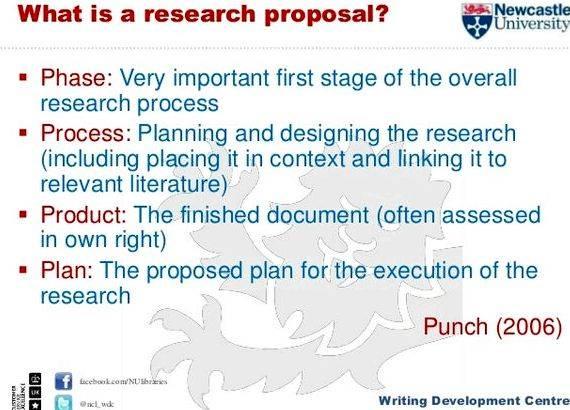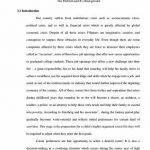The dissertation proposal is an important first step towards writing your final dissertation on a taught or research master’s course, or a PhD level course. Your proposal needs to be unique and it sets the stage for your research and should help you make a clear plan for your final project. Read more about planning your dissertation here .
Dissertation proposals are like the table of contents for your research, and will help you explain what it is you intend to examine, and roughly, how you intend to go about collecting and analysing your data. You won’t be required to have everything planned out exactly, as your topic may change slightly in the course of your research, but for the most part writing your proposal should help you better identify the direction for your dissertation.
When you’ve chosen a topic, you’ll need to make sure that it is both appropriate to your field of study, and narrow enough to be completed by the end of your course. Your dissertation proposal will help you define and determine both of these things, and will also allow your department and instructors to make sure that you are being advised by the best person to help you complete your research.
Narrow the topic down
It’s important that when you sit down to draft your proposal, you’ve carefully thought out your topic, and are able to narrow it down enough to present clear and succinct understanding of what you aim to do and hope to accomplish by doing it. Aiming for 1,000 words or more, your proposal will give an outline of the topic of your dissertation, some of the questions you hope to answer with your research, what sort of studies and type of data you aim to employ in your research, the sort of analysis you will carry out.
Different courses may have different requirements for things like length and the specific information to include, as well as what structure is preferred, so be sure to check what special requirements your course may have.
What should I include in a dissertation proposal?
Your dissertation proposal should have several key aspects, regardless of the structure: the introduction, the methodology. aims and objectives, the literature review, and the constraints of your research.
Introduction
The introduction will state your central research question and give background on the subject, as well as relating it contextually to any broader issues surrounding it. Read more about picking a topic for your dissertation.
Dissertation methodology
The dissertation methodology will break down what sources you aim to use for your research, and what sort of data you will collect from it- either quantitative or qualitative. You may also want to include how you will analyse the data you gather and what if any bias there may be in your chosen methods. Depending on the level of detail that your specific course requires, you may also want to explain why your chosen approaches to gathering data are more appropriate to your research than others.
Aims and Objectives
Your dissertation proposal should also include the aims and objectives of your research. Be sure to state what your research hopes to achieve, and what outcomes you predict. You may also need to clearly state what your main research objectives are, in other words, how you plan to obtain those achievements and outcomes.

The literature review will list the books and materials that you used to do your research. This is where you can list materials that give you more background on your topic, or contain research carried out previously that you refer to in your own studies. It’s also a good place to demonstrate how your research connects to previous academic studies, and how your methods may differ from or be building upon those used by other researchers. While it’s important to give enough information about the materials to show that you have read and understood them, don’t forget to include your analysis of their value to your work.
Constraints of your research
Lastly, you will also need to include the constraints of your research. Many topics will have broad links to numerous larger and more complex issues, so by clearly stating the constraints of your research, you are displaying your understanding and acknowledgment of these larger issues, and the role they play by focusing your research on just one section or part of the subject.
Dissertation proposal example
The structure of your dissertation proposal will depend on your specific course requirements. Some courses may specify that the aims and objectives of your research be a separate section in your proposal, or that you do not need to include a methodology or literature review section.
Once you know what sections you need or do not need to include, then it may help focus your writing to break the proposal up into the separate headings, and tackle each piece individually. You may also want to consider including a title. Writing a title for your proposal will help you make sure that your topic is narrow enough, as well as help keep your writing focused and on topic.
One example of a dissertation proposal structure is the following headings, either broken up into sections or chapters depending on the required word count:
Related Editorial Links
Our consultants assist students to focus on a specific gap in the knowledge and meet
the requirements in this chapter needed to defend the choice of that gap.
Chapter 1, with a highly focused review of the literature, and is normally the “prospectus” that a committee approves before the “proposal” to start research is approved. After the prospectus is approved, some of the review of literature may be moved into Chapter 2, which then becomes part of the proposal to do research.
Chapter 1 is the engine that drives the rest of the document, and it must be a complete empirical argument as is found in courts of law. It should be filled with proofs throughout. It is not a creative writing project in a creative writing class; hence, once a word or phrase is established in Chapter 1, use the same word or phrase throughout the dissertation. The content is normally stylized into five chapters, repetitive in some sections from dissertation to dissertation. A lengthy dissertation may have more than five chapters, but regardless, most universities limit the total number of pages to 350 due to microfilming and binding considerations in libraries in those institutions requiring hard copies.
Use plenty of transitional words and sentences from one section to another, as well as subheadings, which allow the reader to follow the writer’s train of thought. Following is an outline of the content of the empirical argument of Chapter 1. Universities often arrange the content in a different order, but the subject matter is the same in all dissertations because it is an empirical “opening statement” as might be found in a court of law. (Note that a dissertation could also be five pages of text and 50 pages of pictures of dragonfly wings and qualify for a Doctor’s degree in entomology.)
State the general field of interest in one or two paragraphs, and end with a sentence that states what study will accomplish. Do not keep the reader waiting to find out the precise subject of the dissertation.
Background of the Problem
This section is critically important as it must contain some mention of all the subject matter in the following Chapter 2 Review of the Literature 2 and the methodology in Chapter 3. Key words should abound that will subsequently be used again in Chapter 2. The section is a brief two to four page summary of the major findings in the field of interest that cites the most current finding in the subject area. A minimum of two to three citations to the literature per paragraph is advisable. The paragraphs must be a summary of unresolved issues, conflicting findings, social concerns, or educational, national, or international issues, and lead to the next section, the statement of the problem. The problem is the gap in the knowledge. The focus of the Background of the Problem is where a gap in the knowledge is found in the current body of empirical (research) literature.
Statement of the Problem
Arising from the background statement is this statement of the exact gap in the knowledge discussed in previous paragraphs that reviewed the most current literature found. A gap in the knowledge is the entire reason for the study, so state it specifically and exactly. Use the words “gap in the knowledge.” The problem statement will contain a definition of the general need for the study, and the specific problem that will be addressed.
Purpose of the Study
The Purpose of the Study is a statement contained within one or two paragraphs that identifies the research design, such as qualitative, quantitative, mixed methods, ethnographic, or another design. The research variables, if a quantitative study, are identified, for instance, independent, dependent, comparisons, relationships, or other variables. The population that will be used is identified, whether it will be randomly or purposively chosen, and the location of the study is summarized. Most of these factors will be discussed in detail in Chapter 3.
Significance of the Study
The significance is a statement of why it is important to determine the answer to the gap in the knowledge, and is related to improving the human condition. The contribution to the body of knowledge is described, and summarizes who will be able to use the knowledge to make better decisions, improve policy, advance science, or other uses of the new information. The “new” data is the information used to fill the gap in the knowledge.
Primary Research Questions
The primary research question is the basis for data collection and arises from the Purpose of the Study. There may be one, or there may be several. When the research is finished, the contribution to the knowledge will be the answer to these questions. Do not confuse the primary research questions with interview questions in a qualitative study, or survey questions in a quantitative study. The research questions in a qualitative study are followed by both a null and an alternate hypothesis.
A hypothesis is a testable prediction for an observed phenomenon, namely, the gap in the knowledge. Each research question will have both a null and an alternative hypothesis in a quantitative study. Qualitative studies do not have hypotheses. The two hypotheses should follow the research question upon which they are based. Hypotheses are testable predictions to the gap in the knowledge. In a qualitative study the hypotheses are replaced with the primary research questions.
In Chapter 1 this is a summary of the methodology and contains a brief outline of three things: (a) the participants in a qualitative study or thesubjects of a quantitative study (human participants are referred tyo as participants, non-human subjects are referred to as subjects), (b) the instrumentation used to collect data, and (c) the procedure that will be followed. All of these elements will be reported in detail in Chapter 3. In a quantitative study, the instrumentation will be validated in Chapter 3 in detail. In a qualitative study, if it is a researcher-created questionnaire, validating the correctness of the interview protocol is usually accomplished with a pilot study. For either a quantitative or a qualitative study, using an already validated survey instrument is easier to defend and does not require a pilot study; however, Chapter 3 must contain a careful review of the instrument and how it was validated by the creator.
In a qualitative study, which usually involves interviews, the instrumentation is an interview protocol – a pre-determined set of questions that every participant is asked that are based on the primary research questions. A qualitative interview should contain no less than 10 open-ended questions and take no less than 1 hour to administer to qualify as “robust” research.
In the humanities, a demographic survey should be circulated with most quantitative and qualitative studies to establish the parameters of the participant pool. Demographic surveys are nearly identical in most dissertations. In the sciences, a demographic survey is rarely needed.
The theoretical framework is the foundational theory that is used to provide a perspective upon which the study is based. There are hundreds of theories in the literature. For instance, if a study in the social sciences is about stress that may be causing teachers to quit, Apple’s Intensification Theory could be cited as the theory was that stress is cumulative and the result of continuing overlapping, progressively stringent responsibilities for teachers that eventually leads to the desire to quit. In the sciences, research about new species that may have evolved from older, extinct species would be based on the theory of evolution pioneered by Darwin.
Some departments put the theoretical framework explanation in Chapter 1; some put it in Chapter 2.
Assumptions, Limitations, and Scope (Delimitations)
Assumptions are self-evident truths. In a qualitative study, it may be assumed that participants be highly qualified in the study is about administrators. It can be assumed that participants will answer truthfully and accurately to the interview questions based on their personal experience, and that participants will respond honestly and to the best of their individual abilities.
Limitations of a study are those things over which the research has no control. Evident limitations are potential weaknesses of a study. Researcher biases and perceptual misrepresentations are potential limitations in a qualitative study; in a quantitative study, a limitation may be the capability of an instrument to accurately record data.
Scope is the extent of the study and contains measurements. In a qualitative study this would include the number of participants, the geographical location, and other pertinent numerical data. In a quantitative study the size of the elements of the experiment are cited. The generalizability of the study may be cited. The word generalizability, which is not in the Word 2007 dictionary, means the extent to which the data are applicable in places other than where the study took place, or under what conditions the study took place.
Delimitations are limitations on the research design imposed deliberately by the researcher. Delimitations in a social sciences study would be such things as the specific school district where a study took place, or in a scientific study, the number of repetitions.
Definition of Terms
The definition of terms is written for knowledgeable peers, not people from other disciplines As such, it is not the place to fill pages with definitions that knowledgeable peers would know at a glance. Instead, define terms that may have more than one meaning among knowledgeable peers.
Summarize the content of Chapter 1 and preview of content of Chapter 2.
Source: Barbara von Diether, EdD






 Dissertation proposal sample history and physical form
Dissertation proposal sample history and physical form Crise de cuba dissertation writing
Crise de cuba dissertation writing Dissertation proposal sample sociology observation
Dissertation proposal sample sociology observation Unisa theses and dissertations online
Unisa theses and dissertations online Crawford university of memphis dissertation
Crawford university of memphis dissertation






